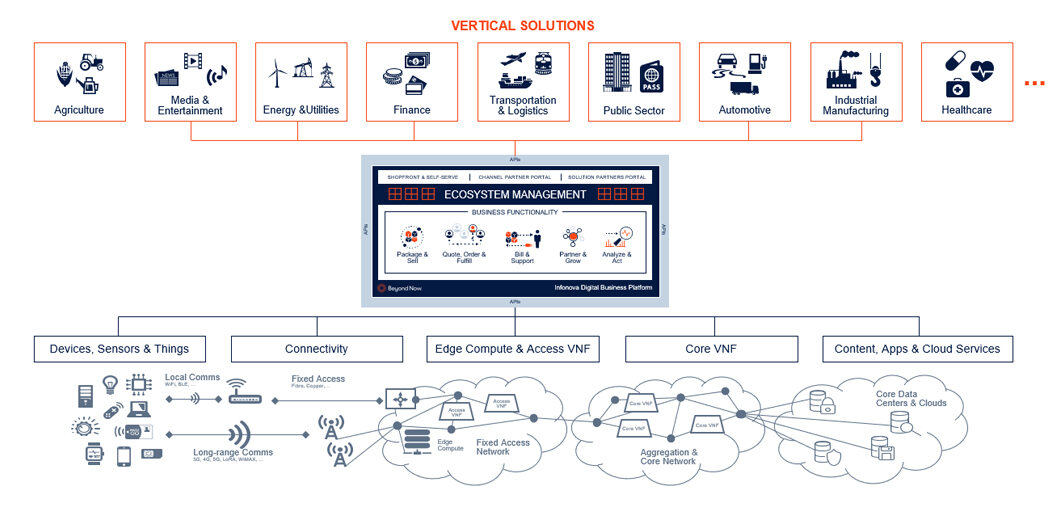
As digital has become mainstream and the speed of change continues to accelerate, companies need to reinvent their business models and transform to ecosystem-enabled solution providers. And never has this been more evident than during the days of Covid-19 when those who had been slow to digitize, have felt the strain of not having a solid cloud-based IT environment in place.
This is leading to a growing hunger among CSPs to drive new revenue from advanced technologies such as edge, AI and 5G. However, our report on the enterprise opportunities for CSPs revealed that nearly half of them recognized that their current IT set-up does not give them the flexibility to launch offerings quickly into market. Here’s why I think a Digital Business Platform is the solution:
Nowadays, enterprises need to have the ability to rapidly launch, sell and monetize new digital services in days or weeks, not months. They need to close innovation gaps through collaboration and co-creation of offerings with an ecosystem and adopt a digital platform business model to expand market reach and create network effect.
However, the existing IT systems of many businesses were not built for such an environment and they struggle to provide the required level of agility and flexibility. The smallest changes take multiple months to implement and test, systems reach end of life of their support agreements and upgrades to newer versions are impossible or take years due to the high level of customization. While the whole world is praising microservices and the cloud, CTIOs can only dream about this while they must spend most of their time and budget fighting the day-to-day challenges of their legacy IT.
But how can you create an environment that enables you to quickly experiment and deploy changes for launching new services and transforming the business model? A new kind of technology system is required, a Digital Business Platform (DBP) that overlays and abstracts the existing IT environment and allows enterprises to quickly onboard new services and orchestrate partners.
While the traditional systems continue to do what they were designed for, the DBP overlays the existing IT and reuses it to deal with the complex fulfillment processes. The introduction of a DBP is not meant to replace the existing IT – at least not in the first place. Its main purpose is to enable the business to launch and monetize new types of services, combine them with legacy services, and sell them as integrated solutions to the market.

5G, edge and IoT will force CSPs to adapt digital platform business models and marketplaces to find ways to manage commercial relationships inside a multi-party environment. A digital business platform allows you to access new revenue streams through the collaboration and co-creation of joint offerings with a partner ecosystem. Enterprise customers are ditching individual bits and pieces that they have to stitch together; instead, they are looking for a complete end-to-end solution that solves defined business problems. And they want them now, not in a years’ time. Starting a lengthy R&D process to develop new solutions with a blank sheet of paper is too time consuming. Seeking out the right partners, onboarding them and combining their products with others to form co-created solutions is the way forward. A digital business platform allows you to do exactly that, as it provides the APIs and functionality to create and launch multi-party offerings and orchestrate the fulfillment processes across the various business partners.
It’s clear that the functional capabilities of a DBP are crucial, but there are more pieces to the jigsaw puzzle. The non-functional capabilities hold even more weight as speed and flexibility are the essence to market success. Rapid setup and deployment of a new platform are essential as well as prototyping capabilities that enable enterprises to quickly test and launch new offerings and business models. Ease of integration with well documented Open APIs covering the whole functionality in a modular way is another very important aspect to consider in order to achieve the required speed for launching new propositions to the market.
It needs to be possible that via a partner ecosystem, solutions can be onboarded within days, CSPs can innovate and test the market and rapidly launch at scale. However, companies also need to be able to put the brakes on any ideas that were not successful. The digital business platform therefore needs to be architected for scalability and elasticity so that the infrastructure resources can automatically be adjusted to meet current and future demand in a cost-effective manner.
Incorporating a digital platform model into the current business model requires a clear understanding of the synergies between old and new models. It’s easy to stay focused on mainstream solutions such as BSS, but with the speed of innovation driving the creation of new technology, it’s never been more important to understand and evaluate how your business can adapt accordingly.
Agility is the answer – facilitating that scalability and elasticity that enables organizations of any size to start small and scale depending on the success of the business. But as a first step, find out which customer needs are poorly served by existing legacy services, then consider evolving to an asset-light, digital business platform model.
Microservice and container-based architectures delivered through DevOps best practices are key enablers for achieving this agility. The use of managed services in the public cloud allows you to start fast and scale with the business while bringing the required level of scalability, elasticity, robustness, and security. Again, the challenge is not just the technology, but more so the approach that is taken to tackle the problem. It’s not usually possible to transform the whole organization at once, and people that understand the technology and the business are a scarce resource.
In order to achieve return on investment, it’s unwise to rebuild what is already out there as standard software or to waste your resources on operating software products and infrastructure, even if you have the right talent for doing this. What’s more important is to place your talents where they can make a real difference for the company. Focus them on market differentiation and customer experience, not on rebuilding existing solutions and competing with infrastructure providers and software vendors. Standard functions can be provided by third parties and a SaaS based delivery model providing continuous upgrades is the preferred choice for offloading the operational complexity to the vendor.
Keeping these principles in mind, it’s possible to deploy a new platform and launch the first services to the market in a matter of weeks and roll out new services on a weekly basis from there.
New platform-based business models are something CSPs must adopt if they are to survive into the next decade, especially after the recent lesson given by the Covid-19 pandemic. Use an ecosystem of partners to bridge gaps in capabilities, co-invest and co-innovate with you. Select the pathway that will help you get there fast while realizing synergies from existing business and identify the minimum viable product that will allow you to put this to the test. The result will be a higher level of innovation and revenue growth that will drive your business forward in a post-pandemic age.
